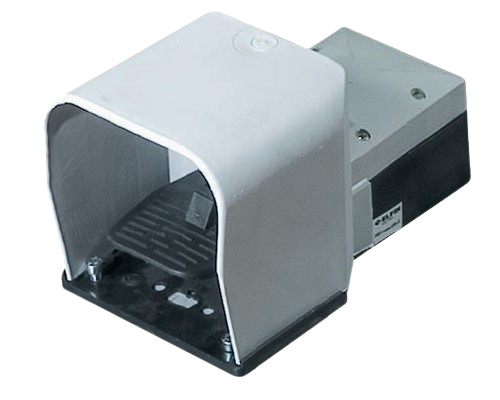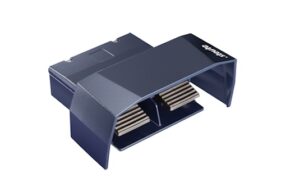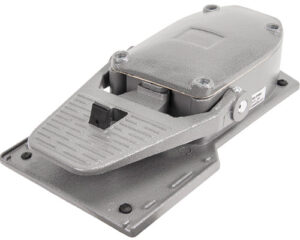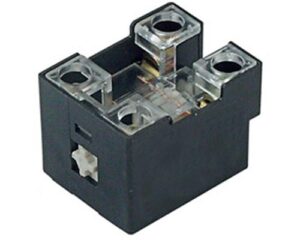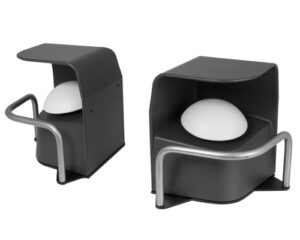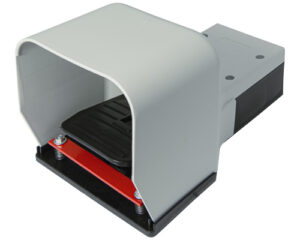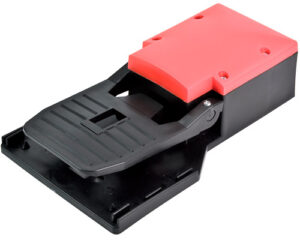Safety Foot Pedal Switches
What Are Foot Pedal Switches? Definition and Basic Functions Foot pedal switches, also known as foot switches or foot-activated switches, are control devices operated by…
What Are Foot Pedal Switches?
Definition and Basic Functions
Foot pedal switches, also known as foot switches or foot-activated switches, are control devices operated by the user’s foot, allowing for hands-free activation of electrical or mechanical functions. These switches come in a range of formats—from momentary switches to maintained action switches—and are commonly found in electric foot switches, pedal controller power switches, and USB foot pedal switches.
Designed for ergonomic efficiency and non-electrical operator control applications, foot switches enable the user to control devices without using their hands, reducing operator fatigue and improving workflow. Many models, such as those from Steute or Elfin, include features like treadle guards, modular foot switch platforms, or switch covers for safety and durability in heavy-use environments.
Common Uses and Applications
Foot pedal switches are versatile and widely used across industries and applications:
- Industrial machinery: Activating or halting machines without removing hands from workpieces.
- Medical equipment: Enabling hands-free applications in surgical or dental environments.
- Musical and tap-tempo applications: Controlling effects or timing tools using dual pedal foot switches or foot switch 3PDT pins.
- Woodworking and power tools: Operating lathes, saws, or drills via electric foot switches with durable construction and cord strain relief.
- Computing and accessibility: Programmable USB foot pedal switches are increasingly used in professional applications and by users needing assistive control alternatives.
Whether you’re using a cart foot switch made of Cast Aluminum, a Bluetooth footswitch, or a soft touch switch with a 5-ft cable, the variety of standard products and value-added products in this category make foot pedal switches a key solution for hands-free, precise, and efficient control.
Types of Foot Pedal Switches
Single-Action vs. Dual-Action
Foot pedal switches are commonly available in single-action or dual-action configurations, depending on the application’s control requirements.
- Single-action foot switches (like the momentary control switch) perform one operation—such as turning a machine on or off—when pressed. These are ideal for simple, repetitive tasks like operating a floor lamp foot switch or controlling basic machinery functions.
- Dual-action or double-pedal foot switches offer independent control over two separate functions. For example, a dual switch design may allow forward and reverse operation on a machine, or control two tools from one pedal. These are often used in tap tempo applications, musical settings, or cart foot switch installations requiring more complex inputs.
Products like the Elfin Single Foot Pedal and Double Foot Switches with treadle guards are popular among users looking for more robust and flexible functionality. Many custom foot switch solutions also allow tailored configurations of dual pedals for industry-specific tasks.
Electric vs. Pneumatic
Electric foot switches dominate most applications, offering straightforward wiring and compatibility with standard electrical switches. These are found in woodworking shops, medical facilities, and production lines. Features like 8-foot cords, cord with polarized plug outlets, and reset control switch options make them easy to integrate and operate.
Pneumatic foot switches, on the other hand, use air pressure rather than electricity to actuate control. These are often chosen for environments where non-electrical operator control is preferred—such as in flammable or wet areas. Pneumatic switches are especially useful in safety-critical environments where isolating electrical current enhances reliability and reduces risk.
While electric foot switches remain the most common, pneumatic foot pedal switches continue to gain popularity in cleanroom, hazardous, and fluid-handling applications due to their mechanical simplicity and durability.
Advantages of Using Foot Pedal Switches
Hands-Free Operation
One of the most valuable benefits of foot pedal switches is their ability to provide hands-free control, allowing operators to focus on manual tasks while activating machinery or systems with their feet. This improves workflow, especially in environments where precision and timing are essential—such as woodworking, surgical procedures, or assembly lines.
Whether using a USB foot pedal switch, a floor foot switch, or a momentary control switch, users can trigger actions without shifting their hands away from work surfaces, reducing interruptions and improving safety. This is especially beneficial for non-electrical operator control applications, such as those involving pneumatic foot switches or in wet environments where hand contact with controls may be unsafe or inconvenient.
Ergonomic Benefits
Foot switches are also designed with ergonomics in mind, helping to minimize strain and fatigue during extended use. By offloading certain control tasks to the feet, these switches reduce repetitive hand motions and awkward body positioning.
Features like soft touch switches, treadle guards, and light-action pedals help users apply precise control with minimal force. Models such as the Elfin Single Foot Pedal or the Elfin Thermoplastic Foot Switch are tailored for comfort and smooth actuation, improving usability for operators of all physical capacities.
Additionally, dual-pedal and wide-pedal formats support left- and right-foot operation, allowing for customized setups that cater to professional applications, tap tempo use, or accessibility needs—all while enhancing the overall user experience.
Broader Integration with Safety & Automation Systems
In modern industrial environments, foot pedal switches are only one part of an integrated safety architecture. These systems will work in tandem with various critical components such as safety PLCs, safety contactors or safety light curtains (including muting light curtains) to ensure real-time hazard detection and safe machine shutdown. Common peripheral safety devices like the emergency stop button, two hand station, and emergency stop rope pull are all effectively managed by the safety PLC’s logic structure.
Advanced installations frequently incorporate safety relays, safety non-contact switches, RFID switches, mechanical interlock switches, and solenoid locking switches—each adding specific protective functions to the machinery. To maintain continuous system health, engineers also deploy standstill monitors, speed monitors, soft starters, and reversing contactors within their automation frameworks. For measuring the product itself, solutions such as measurement light curtains can be integrated.
Beyond motion and logic safety, electrical condition monitoring is equally essential. Devices like insulation monitors, battery monitors, current monitors, voltage monitoring relays, phase sequence relays, undervoltage relays, and undercurrent monitoring relays are often integrated to detect anomalies in power flow or equipment performance, with this data displayable on HMI Touch Panels or similar systems. To support reliable operation, high-quality power relays and regulated power supplies are essential.
Key Features to Consider
Durability and Material
When selecting a foot pedal switch, durability is a top priority—especially in heavy-duty or industrial settings. Switches like the Cart Foot Switch Cast Aluminum or the Pedal Foot Switch Heavy Duty Aluminum Cast with Guard are built with rugged enclosures to withstand impact, foot pressure, and daily wear.
Materials such as cast aluminum, reinforced polymers, and stainless steel ensure long-lasting performance, even in high-use applications. Features like cord strain relief, switch covers, and modular foot switch platforms also protect the device in harsh operating environments like workshops, medical bays, or construction zones.
Voltage and Current Ratings
Every foot switch must match the electrical requirements of the system it controls. Typical models support ratings such as 10A at 125VAC, ensuring safe and effective power switching. Devices used for motor foot control, electrical machinery, or momentary switching functions must be evaluated based on the system’s voltage and current draw.
Using an underrated switch can cause overheating or failure, while an over-engineered model may be unnecessarily expensive. It’s important to select a switch with the right cable gauge, wire insulation, and power rating for your task.
Safety Features
Foot switches can pose hazards if accidentally triggered. That’s why many models include treadle guards, switch covers, or enclosures that prevent unintentional activation. For applications involving emergency stop functions, reset control switches, or high-risk environments, look for units with built-in lockouts, non-slip bases, or dual-step activation logic.
Advanced models integrate features such as soft click switches, foot switch safety warnings, or position locks for maximum protection. Whether you’re using a USB foot pedal switch, pneumatic model, or control foot switch, ensuring proper safety features can reduce the risk of accidents and extend product life.
Installation of Foot Pedal Switches
Compatibility with Different Devices
Foot pedal switches are available in a variety of configurations, making them compatible with a broad range of devices—whether industrial, commercial, or consumer-grade. Popular models such as the Elfin Single Foot Pedal are designed for plug-and-play integration with PCs, machinery, medical equipment, or power tools.
Before installation, it’s essential to consider:
- Connector types (e.g., single cable, 5-ft cable, USB, or hard-wired leads)
- Switch operation type (momentary vs maintained)
- Voltage and current compatibility with your machine or control circuit
- Device-specific requirements, such as foot switches with 3PDT pins, SPDT contacts, or modular footswitch accessories
Many modular platforms also support custom foot switch configurations, including options for tap tempo applications, pedal controller power switches, and multi-function switches.
Step-by-Step Installation Process
Installing a foot pedal switch is typically straightforward, especially for pre-wired or modular models. Below is a general guide:
- Power Down the System
Ensure that the equipment you are installing the foot switch on is powered off and unplugged to avoid electrical hazards. - Inspect the Foot Switch and Cables
Check the product for any damage, verify that the cord with plug or wire cable connector is intact, and confirm that it matches your device’s input specification. - Mount the Switch
Position the switch where the operator can reach it comfortably with their foot. For heavy-duty foot switches, use mounting brackets or place them on non-slip flooring to prevent movement. - Connect to the Device
-
- For USB foot switches, plug the device directly into a PC or programmable interface.
- For hard-wired models, connect the leads to the appropriate terminals in the control circuit, matching polarity and function.
- For pneumatic switches, attach the air hose securely and test for leaks.
- Secure and Test
Once connected, ensure any strain relief components or switch covers are in place. Power on the device and test the switch for correct operation—press to activate and release to deactivate (or as programmed). - Label and Document
If used in an industrial environment, label the switch for its function and document the installation in your control system or safety logs.
Proper installation helps prevent bad switch behavior and ensures that your foot-activated switch performs reliably over time, whether for hands-free applications or external switch controls.
Frequently Asked Questions
Troubleshooting Common Issues
Foot pedal switches are durable, but occasional issues may arise due to wear, wiring faults, or environmental factors. Here are some of the most common problems and their solutions:
- Switch not responding: Check for a bad switch contact, disconnected wire cable connector, or a faulty plug. For USB foot pedal switches, ensure drivers or software are correctly installed.
- Intermittent operation: This could be caused by a damaged cord or loose internal terminals. Inspect the cord strain relief and verify the switch cover isn’t restricting movement.
- Unintended activation: If the switch is triggering without being pressed, inspect for debris under the treadle, damaged momentary switch mechanisms, or overly sensitive contacts—especially on soft touch switches.
- Electrical buzzing or overheating: Ensure the switch’s voltage and current ratings match your equipment. Using a 10A switch like the Aluminum Foot Switch – 10A SPDT on a higher load can cause thermal issues.
If using pneumatic foot switches, leaks or hose detachment can also lead to unresponsive actuation. In such cases, replace the tubing or check the air pressure regulation system.
Best Practices for Maintenance
To ensure long service life and reliable performance, follow these maintenance tips:
- Inspect regularly: Look for physical wear, loose components, or degraded cables, especially on heavy-duty models used in demanding environments.
- Clean the treadle: Keep the footplate free of dust, oil, or debris. Use a dry cloth or a lightly damp wipe to clean non-electrical components.
- Protect against spills and impacts: Install switch covers, place the switch away from high-traffic zones, and consider raised treadle guards where accidental pressing is a concern.
- Test periodically: For momentary switches or dual pedal foot switches, press each pedal and confirm correct actuation. For USB and electric foot switches, verify system recognition and proper output.
- Use correct accessories: Replace damaged cords with compatible 5-ft cables, and avoid modifying the wiring unless supported by the manufacturer.
Proper care ensures your foot pedal switch functions as expected—whether it’s a Cart Foot Switch Cast Aluminum, a GlassOuse Foot Switch, or a modular foot switch platform in a professional setting.
Related Products and Accessories
Complementary Electrical Components
To ensure safe and reliable operation, foot pedal switches are often used alongside a variety of electrical components. These include:
- Control circuit devices such as relays, contactors, or reset control switches to manage signal flow and logic.
- Power adapters and motor controllers that interpret pedal input and regulate machine behavior.
- Momentary control switch modules or multi-position switches used in dual pedal or tap tempo applications.
- Footswitch bellows and modular footswitch platforms that protect the internal mechanisms from dust and mechanical wear, extending product life in heavy-duty environments.
For industrial setups, combining a Cart Foot Switch – 10A SPDT with emergency stop switches, pneumatic safety circuits, or manual override systems creates a comprehensive, safety-compliant control solution.
Adapters and Connectors
Proper connectivity is essential for foot switches, especially in varied environments ranging from workshops to digital interfaces. Key accessories include:
- M12 connectors, angled plugs, and cable glands for industrial wiring.
- USB adapters for plug-and-play functionality in computing, gaming, and accessibility applications (e.g., USB Foot Pedal Switch for Video Game PC).
- Single cable extensions and 8-foot cords for wider reach and easier installation, often bundled with UL-Certified 4-pack foot pedal switches.
- Cord strain relief fittings, wire harness clips, and cords with polarized plugs to prevent stress-related cable damage and ensure long-term signal reliability.
These accessories not only support seamless integration but also offer enhanced safety, durability, and flexibility when configuring custom foot switch solutions for various professional applications.
Final Considerations
Choosing the Right Foot Pedal Switch for Your Needs
Selecting the ideal foot pedal switch depends on several key factors, including application type, electrical load, user preference, and safety requirements. Whether you’re opting for a momentary switch, a dual pedal foot switch, or a USB foot pedal switch, be sure to consider:
- Voltage and current ratings that match your equipment
- The desired activation method (momentary, maintained, or toggle)
- Treadle guard needs for safety and protection
- Environmental factors like dust, moisture, or vibration
- Whether the application involves tap tempo, machine operation, or non-electrical operator control
For heavy-duty industrial applications, models like the Cart Foot Switch Cast Aluminum or Pedal Foot Switch with Guard offer both performance and protection. For lighter or digital tasks, Bluetooth footswitches, soft touch switches, or USB-compatible options may be ideal.
Integration with Flooring and Workspace
Proper workspace integration maximizes usability and safety. When installing foot pedal switches:
- Place them in accessible, intuitive positions based on operator movement.
- Use non-slip bases, mounting plates, or foot cord organizers to prevent sliding or tangling.
- Consider foot traffic, surrounding machinery, and operator handedness when determining placement.
- In cleanrooms or sensitive environments, pneumatic foot switches with no exposed electrical components are ideal.
Optimizing switch placement reduces strain, boosts efficiency, and enhances overall workflow—especially in settings involving professional applications, robotics, or repetitive motion control.
Additional Resources
Guides for Further Learning
To dive deeper into the selection and application of foot pedal switches, consider exploring:
- Manufacturer installation manuals and product specification sheets
- Technical guides on electrical switch integration
- Safety standards like IEC 60204-1 and UL 508
- Training modules focused on machine safety and operator ergonomics
These resources are particularly helpful for system integrators, safety officers, and maintenance engineers.
Recommended Websites and Communities
Staying connected with expert communities and reliable sources can help you stay current with trends, troubleshooting techniques, and product innovations:
- Control Design Magazine – Industry news on automation hardware and control systems
- IEEE Xplore Digital Library – Research on electrical switches and industrial control design
- Electrical Engineering Stack Exchange – Community-driven advice on installation and wiring
- Manufacturer support pages like those of SSC Controls, IDEC, and Omron
Engaging with these platforms will ensure you’re equipped with the latest insights, helping you choose and maintain the right foot switch solution with confidence.
